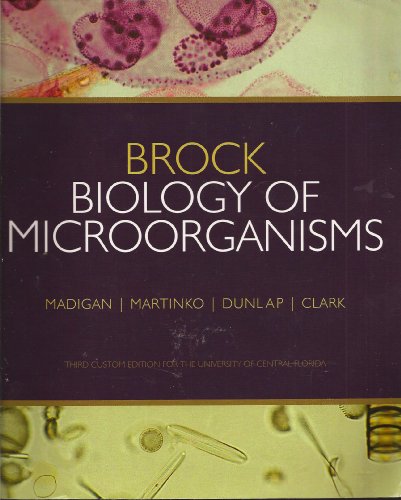Brock Biology Of Microorganisms 9-13th Edition Madigan Martinko And Parker
Posted By admin On 03.10.19Microscopes and Microscopy. Overview of Cell Structure: Prokaryotes and Eukaryotes. Cytoplasmic Membrane: Structure. Cytoplasmic Membrane: Function. The Cell Wall of Prokaryotes: Peptidoglycan and Related Molecules. The Outer Membrane of Gram-Negative Bacteria.
Cell-Wall Synthesis and Cell Division. Arrangement of DNA in Prokaryotes. Flagella and Motility. Bacterial Behavior: Chemotaxis, Phototaxis and Other Taxes. Bacterial Cell Surface Structure and Cell Inclusions. Gas Vesicles. The Nucleus: Defining Organelle of Eukaryotes.
AbeBooks.com: Brock Biology of Microorganisms (10th Edition) (712) by Michael T. Madigan; John Martinko; Jack Parker and a great selection of similar New. Brock Biology of Microorganisms. Madigan, Martinko, and Parker. 10th edition. The Website for Brock Biology of Microorganisms will help you achieve success in.
Organelles: Mitochondria and Chloroplasts. Comparisons of the Prokaryotic and Eukaryotic Cell. Nutrition and Metabolism. Overview of Metabolism. Microbial Nutrition. Culture Media. Catalysis and Enzymes.
Oxidation Reduction. Electron Carriers. High Energy Compounds. Fermentation and Substrate-Level Phosphorylation. Glycolysis: The Embden-Meyerof Pathway. Electron Transport Systems. Energy Conservation from Electron Transport.
Carbon Flow: The Citric Acid Cycle. Balance Sheet of Aerobic Respiration and Energy Storage. Alternate Modes of Energy Generation: An Overview. Biosynthetic Pathways: Anabolism.
Sugar Metabolism. Amino Acid Biosynthesis. Purine and Pyrimidine Biosynthesis. Biosynthesis of Fatty Acids. Microbial Growth.
General Properties of Viruses. Nature of the Virion. The Virus Host. Quantification of Viruses. General Features of Virus Reproduction.
Steps in Virus Multiplication. Overview of Bacterial Viruses. RNA Bacteriophages. Single-Stranded Icosahedral DNA Bacteriophages. Single-Stranded Filamentous DNA Bacteriophages.
Double-Stranded DNA Bacteriophages: Lytic Viruses. Temperate Bacteriophages: Lysogeny and Lambda. A Transposable Phage: Bacteriophage Mu. Overview of Animal Viruses. Positive-Strand RNA Animal Viruses. Negative-Strand RNA Viruses.
Double-Stranded RNA Viruses: Reoviruses. Replication of DNA Viruses of Animals. Viroids and Prions. Microbial Genetics.

Molecular Cloning. Plasmids as Cloning Vectors. Bacteriophage Lambda as a Cloning Vector. Other Vectors. Hosts for Cloning Vectors. Finding the Right Clone.
Expression Vectors. Synthetic DNA.
Amplifying DNA: The Polymerase Chain Reaction. Cloning and Expression of Mammalian Genes in Bacteria. In Vitro and Site-Directed Mutagenesis.
Practical Applications of Genetic Engineering. Production of Mammalian Products and Vaccines by Genetically Engineered Microorganisms. Genetic Engineering in Plant Agriculture. Genetic Engineering in Animal and Human Genetics. Genetic Engineering as a Microbial Research Tool.
Summary of Principles at the Basis of Genetic Engineering. Microbial Growth Control. Industrial Microorganisms and Products. Growth and Product Formation in Industrial Processes. Characteristics of Large-Scale Fermentations.
Fermentation Scale-Up. Antibiotics: Isolation and Characterization. Antibiotics: Industrial Production. Vitamins and Amino Acids. Microbial Bioconversion. Citric Acid and Other Organic Compounds. Alcohol and Alcoholic Beverages.
Food from Microorganisms. Sewage and Wastewater Microbiology. Metabolic Diversity among the Microorganisms.
Energy-Yielding Metabolism. Role of Chlorophyll and Bacteriochlorophyll in Photosynthesis. Anoxygenic Photosynthesis. Oxygenic Photosynthesis.
Additional Aspects of Photosynthetic Light Reactions.: Carotenoids and Phycobilins. Autotrophic CO, Fixation: The Calvin Cycle. Chemolithotrophy: Energy from the Oxidation of Inorganic Electron Donors. Hydrogen-Oxidizing Bacteria. Sulfur Bacteria. Iron-Oxidizing Bacteria. Ammonium and Nitrite-Oxidizing Bacteria.
Summary of Autotrophy and ATP Production among Chemolithotrophs. Anaerobic Respiration. Nitrate Reduction and the Denitrification Process. Sulfate Reduction.
Carbon Dioxide as an Electron Acceptor: Methanogenesis and Acetogenesis. Other Electron Acceptors for Anaerobic Respiration. Fermentations: Energetic and Redox Considerations. Fermentations: Diversity, Syntrophy and Role in Anoxic Decomposition.
Herose, Pentose, and Polysaccharide Utilization. Organic Acid Metabolism. Lipids ad Microbial Nutrients. Molecular Oxygen (O,) as a Reactant in Biochemical Processes. Hydrocarbon Transformations.
Nitrogen Metabolism. Nitrogen Fixation. Microbial Ecology.
Microorganisms in Nature. Methods in Microbial Ecology. Enrichment and Isolation Methods. Identification and Quantification: Nucleic Acid Probes, Fluorescent Antibodies and Viable Counts. Microbial Activity Measurement: Radioisotopes and Microelectrodes. Microbial Activity Measurements: Stable Isotopes.
Aquatic Habitats. Terrestrial Environments. Deep-Sea Microbiology.
Hydrothermal Vents. Carbon Cycle. Methanogenesis and Syntrophy. Rumen Microbial Ecosystem.
Biogeochemical Cyles: Nitrogen. Biogeochemical Cycles: Sulfur. Biogeochemical Cycles: Iron. Microbial Leaching.
Biogeochemical Cycles: Trace Metals and Mercury. Petroleum Biodegradation. Biodegradation of Xenobiotics.
Plant-Microorganism Interactions. Agrobacterium and Plant Interactions: Grown Gall and Hairy Root. Root Nodule Bacteria and Symbiosis with Legumes. Microbial Evolution, Systematics and Taxonomy. Purple and Green (A noxygenic, Phototrophic) Bacteria. Chemolithotrophs: The Nitrifying Bacteria.
Chemolithotrophs: Sulfur- and Iron-Oxidizing Bacteria. Chemolithotrophs: Hydrogen-Oxidizing Bacteria.
Methanotrophs and Methylotrophs. Sulfate- and Sulfur-Reducing Bacteria. Homoacetogenic Bacteria.
Budding and Appendaged (Prosthecate) Bacteria. Gliding Bacteria.
Sheathed Bacteria. Free-Living Aerobic Nitrogen-Fixing Bacteria. Acetic Acid Bacteria. Zymomonas and Chromobacterium.
Vibrio and Related Genera. Facultatively Aerobic Gram-Negative Rods.
Neisseria and Other Gram-Negative Cocci. Gram-Positive Bacteria: Cocci.
Lactic Acid Bacteria. Endospore-Forming Gram-Positive Rods and Cocci. High GC Gram-Positive Bacteria: “Actinomycetes.” Coryneform Bacteria. Propionic Acid Bacteria. Filamentous Actinomycetes. Prokaryotic Diversity: Archaea. Cells and Organs of the Immune System.
Immunogens and Antigens. Nonspecific Immunity: Phagocytes and Phagocytosis. Specific Immunity: Lymphocytes. Immunoglobulins (Antibodies). T Cell Receptors.
Histocompatibility Proteins. Cell-Mediated Immunity.
Clonal Selection and Immune Tolerance. Mechanisms of Immunoglobulin Formation.
Genetics and Evolution of Immunoglobulins and T Cell Receptors. The Complement System. Polyclonal and Monoclonal Antibodies. Antigen-Antibody Reactions. Immune Diseases. Immunity to Infectious Diseases. Clinical and Diagnostic Microbiology and Immunology.
Airborne Transmission of Pathogens. Respiratory Infections: Bacterial. Mycobacterium and Tuberculosis. Respiratory Infections: Viral. Why Are Respiratory Infections So Common?
Sexually Transmitted Diseases. Acquired Immunodeficiency Syndrome. Animal-Transmitted Diseases: Rickettsias.
Insect- and Tick-Transmitted Diseases: Rickettsias. Tick- Transmitted Diseases: Lyme Disease. Insect-Transmitted Diseases: Malaria. Insect-Transmitted Diseases: Plague.
Foodborne Diseases. Waterborne Diseases. Public Health and Water Quality. Pathogenic Fungi. Appendix 1: Energy Calculations in Microbial Bioenergetics.
Michael T Madigan
Appendix 2: Advanced Mathematics of Microbial Growth and Chemostat Operation. Appendix 3: Bergey's Classification of Prokaryotes.